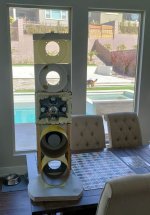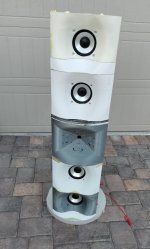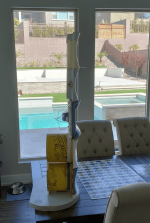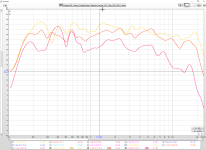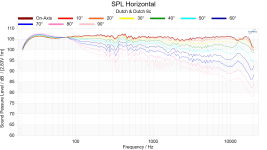No they're basically there because:
1) if you put a cross or something comparable in the exit of the midrange tap, it keeps the shape from sagging while the plastic cools
2) I generally fill the phase plug with polyfill or the like. It's basically a way to suppress some of the high frequencies "spikes" that are out-of-band

In these unfiltered polar measurements of the midrange, you can see there's an out-of-band spike that's 10dB at 2700Hz. The polyfill helps with that. A passive xover can do the job too, but a passive xover doesn't reduce distortion, while an acoustic xover DOES filter out distortion.
1) if you put a cross or something comparable in the exit of the midrange tap, it keeps the shape from sagging while the plastic cools
2) I generally fill the phase plug with polyfill or the like. It's basically a way to suppress some of the high frequencies "spikes" that are out-of-band
In these unfiltered polar measurements of the midrange, you can see there's an out-of-band spike that's 10dB at 2700Hz. The polyfill helps with that. A passive xover can do the job too, but a passive xover doesn't reduce distortion, while an acoustic xover DOES filter out distortion.
what rules are you using to position the midrange taps? I notice in many of your designs they are quite far from the throat.
Speakers looking great!
Speakers looking great!
So this project is officially the most time/effort I've invested in a single project in the last 18 years. The last time I actually came close to actually finishing something was this: https://www.diymobileaudio.com/threads/creating-the-perfect-soundstage.60146/
Though this project is about 50% finished, I'm pulling the plug. Here's a post-mortem:

The main issue with the speakers is cosmetics. When I started building it, my intention was that the baffle would be wide enough to hide all of the crap on the back side of the speaker:

But the more that I worked on the speaker, I ran into a series of cosmetic issues:
* there's no obvious place to put the crossover
* I thought the cylindrical enclosures would look cool like this, but they didn't:

* A HUGE issue was that the array of 5" woofers didn't play as low as I'd hoped. I'd hoped that they'd play down to about 100Hz and I could hand off to my subwoofers, but I wound up with an issue where there was a gap of about one octave between my subs and the woofers:

With a monopole, you can just use a larger enclosure, or trade off some efficiency for a lower cutoff frequency. You can't really do that with a dipole or a cardioid, because you can only maintain a narrow pattern over a limited bandwidth. I'd argue that getting more than about two octaves of bandwidth out of a U-Frame or H-Frame cardioid is probably about the limit.
Though this project is about 50% finished, I'm pulling the plug. Here's a post-mortem:
The main issue with the speakers is cosmetics. When I started building it, my intention was that the baffle would be wide enough to hide all of the crap on the back side of the speaker:
But the more that I worked on the speaker, I ran into a series of cosmetic issues:
* there's no obvious place to put the crossover
* I thought the cylindrical enclosures would look cool like this, but they didn't:

* A HUGE issue was that the array of 5" woofers didn't play as low as I'd hoped. I'd hoped that they'd play down to about 100Hz and I could hand off to my subwoofers, but I wound up with an issue where there was a gap of about one octave between my subs and the woofers:
With a monopole, you can just use a larger enclosure, or trade off some efficiency for a lower cutoff frequency. You can't really do that with a dipole or a cardioid, because you can only maintain a narrow pattern over a limited bandwidth. I'd argue that getting more than about two octaves of bandwidth out of a U-Frame or H-Frame cardioid is probably about the limit.
Post Mortem Pt 2 of 3

Something that I noticed, when I first hooked up the speaker, was that something sounded "off" in the lower treble. The midranges in the Unity horn exhibit quite a peak at 25hz - 9dB in magnitude!
I managed to smooth out that peak using a combination of EQ, polyfill inside of the phase plug of the Unity horn midrange, and a relatively steep low pass xover on the midranges in the Unity horn.
To this day, I can't say with 100% certainty whether that peak is audible or not. When I first hooked up the speakers, I noticed it. But the longer I listened, the less it bugged me, and after a few days I didn't notice it. The published response of the Dayton ND64-16 (see attached) exhibits this combination of a peak followed by a dip, but in the published response it's only half as large. That may be due to smoothing, or horn loading in my horn, or my phase plug, or all of the above.
Make no mistake, the quality of the midrange is one of my favorite things about this speaker. So I'm definitely not "dismissing" the Dayton ND64-16, just advising that you might want to low pass it fairly early/aggressively. Of course, this kind of defeats the purpose of using a 2.5" midrange!
Another thing that complicates the design of the speaker is that the midranges and the tweeter are interacting in quite a complex manner in the octave from 1500Hz to 3000Hz.
For instance, if you look at the magnitude of that peak in the lower treble, it's amplitude is the same on-axis as off-axis. This basically confirms that the peak isn't some interaction from the midrange and tweeter, it's purely being generated by the midrange array. The peak is at 2800hz, 2800Hz is 4.82" long and the midrange taps are spaced 4.75" apart. Normally that will produce a null at 30 degrees off axis at 2800hz:
https://www.diyaudio.com/community/threads/what-causes-off-axis-nulls.342494/
I'm guessing that we DON'T see an off-axis null because the waveguide is "funneling" the radiation of the mids into a narrower beam. The waveguide is basically large enough to constrain the radiation of the midrange array into a "beam" that's about 100 degrees wide, down to about 1200hz.
Something that I noticed, when I first hooked up the speaker, was that something sounded "off" in the lower treble. The midranges in the Unity horn exhibit quite a peak at 25hz - 9dB in magnitude!
I managed to smooth out that peak using a combination of EQ, polyfill inside of the phase plug of the Unity horn midrange, and a relatively steep low pass xover on the midranges in the Unity horn.
To this day, I can't say with 100% certainty whether that peak is audible or not. When I first hooked up the speakers, I noticed it. But the longer I listened, the less it bugged me, and after a few days I didn't notice it. The published response of the Dayton ND64-16 (see attached) exhibits this combination of a peak followed by a dip, but in the published response it's only half as large. That may be due to smoothing, or horn loading in my horn, or my phase plug, or all of the above.
Make no mistake, the quality of the midrange is one of my favorite things about this speaker. So I'm definitely not "dismissing" the Dayton ND64-16, just advising that you might want to low pass it fairly early/aggressively. Of course, this kind of defeats the purpose of using a 2.5" midrange!
Another thing that complicates the design of the speaker is that the midranges and the tweeter are interacting in quite a complex manner in the octave from 1500Hz to 3000Hz.
For instance, if you look at the magnitude of that peak in the lower treble, it's amplitude is the same on-axis as off-axis. This basically confirms that the peak isn't some interaction from the midrange and tweeter, it's purely being generated by the midrange array. The peak is at 2800hz, 2800Hz is 4.82" long and the midrange taps are spaced 4.75" apart. Normally that will produce a null at 30 degrees off axis at 2800hz:
https://www.diyaudio.com/community/threads/what-causes-off-axis-nulls.342494/
I'm guessing that we DON'T see an off-axis null because the waveguide is "funneling" the radiation of the mids into a narrower beam. The waveguide is basically large enough to constrain the radiation of the midrange array into a "beam" that's about 100 degrees wide, down to about 1200hz.
Attachments
Post Morten Pt 3
Something that I mentioned in prior posts in this thread, is that U-Frame cardioids like my woofer array don't work over a large bandwidth.
In the attached measurement, I've shown the full range response of "Nehalem" at 0 degrees (yellow) , 45 degrees (orange) and 90 degrees (red).
You can see that we're getting close to ten decibels of attenuation off axis (which is great) but the U-Frame cardioid is only working over a bandwidth of about one octave, from 160Hz to 320Hz.
As I understand this stuff, if one wanted to increase directivity control from 200Hz to 20khz, to 100Hz to 20Khz, you would need to do one of the following:
1) make the speaker a four or a five way, so that each section is working over a narrow bandwidth
2) or use a really big waveguide, a la Danley SH-50
The second attached pic, shows the polar response that Erin measures of the Dutch & Dutch 8C. The D&D has about 10dB of rejection off-axis, as my speaker does also. The D&D is much smoother overall. I'm guessing the improved smoothness of the D&D is due to:
1) All of the drivers in the D&D are within a wavelength of each other. Since they're packed tightly together, you're not going to see the large swings in response that my speaker exhibits.
2) D&D is a more mature design, it uses FIR DSP and I assume it's been refined for more than a couple of weeks: https://audioxpress.com/article/best-kept-secrets-the-continuous-search-for-reference-speakers
3) Direct radiators are generally smoother than horns. "Nehalem" horn loads five of the nine drivers.
I've been listening to "Nehalem" for a few weeks now, and I'm listening to it while I type this. I'm pretty happy with how it sounds. It's definitely "light" in the bass - it only plays down to about 200Hz. The midrange sounds great. The output above 6khz is about 2-3dB "light" but that can be easily fixed with EQ:

I'm only listening in mono, but even in mono, the speaker "disappears" pretty well.
In summary, the speaker has a great midrange and that Unity "magic." It's very articulate, like most Unity horns are. Though I haven't listened in stereo, even in mono it disappears nicely. What needs improvement is the appearance of the speaker, and how deep it plays.
Something that I mentioned in prior posts in this thread, is that U-Frame cardioids like my woofer array don't work over a large bandwidth.
In the attached measurement, I've shown the full range response of "Nehalem" at 0 degrees (yellow) , 45 degrees (orange) and 90 degrees (red).
You can see that we're getting close to ten decibels of attenuation off axis (which is great) but the U-Frame cardioid is only working over a bandwidth of about one octave, from 160Hz to 320Hz.
As I understand this stuff, if one wanted to increase directivity control from 200Hz to 20khz, to 100Hz to 20Khz, you would need to do one of the following:
1) make the speaker a four or a five way, so that each section is working over a narrow bandwidth
2) or use a really big waveguide, a la Danley SH-50
The second attached pic, shows the polar response that Erin measures of the Dutch & Dutch 8C. The D&D has about 10dB of rejection off-axis, as my speaker does also. The D&D is much smoother overall. I'm guessing the improved smoothness of the D&D is due to:
1) All of the drivers in the D&D are within a wavelength of each other. Since they're packed tightly together, you're not going to see the large swings in response that my speaker exhibits.
2) D&D is a more mature design, it uses FIR DSP and I assume it's been refined for more than a couple of weeks: https://audioxpress.com/article/best-kept-secrets-the-continuous-search-for-reference-speakers
3) Direct radiators are generally smoother than horns. "Nehalem" horn loads five of the nine drivers.
I've been listening to "Nehalem" for a few weeks now, and I'm listening to it while I type this. I'm pretty happy with how it sounds. It's definitely "light" in the bass - it only plays down to about 200Hz. The midrange sounds great. The output above 6khz is about 2-3dB "light" but that can be easily fixed with EQ:
I'm only listening in mono, but even in mono, the speaker "disappears" pretty well.
In summary, the speaker has a great midrange and that Unity "magic." It's very articulate, like most Unity horns are. Though I haven't listened in stereo, even in mono it disappears nicely. What needs improvement is the appearance of the speaker, and how deep it plays.
Attachments
Lycra or Spandex fabric can hide or transform shapes, and look good for very little investment, as can be seen with these table coverings:When I started building it, my intention was that the baffle would be wide enough to hide all of the crap on the back side of the speaker:
But the more that I worked on the speaker, I ran into a series of cosmetic issues:
* there's no obvious place to put the crossover
Lots of pros use covers on weddings and corporate gigs to blend or hide their speakers and stands.
Like any good speaker cloth, Spandex has almost no effect on HF transmission.
That said, it won't fix any of the acoustic problems..
Art
I didn't realize you could buy a "sock" like that, I'll need to check that out. I own a set of Yamaha DXR 12 prosound speakers, and when I bought them, my intention was to try and make them pretty enough for my living room.
I tried wrapping them in spandex myself, using yards of the material, but abandoned the project because I couldn't keep it from "bunching up" on the sides.
But those socks should solve that, because, well they're "sock shaped!" Simply a better fit.
I tried wrapping them in spandex myself, using yards of the material, but abandoned the project because I couldn't keep it from "bunching up" on the sides.
But those socks should solve that, because, well they're "sock shaped!" Simply a better fit.
In the 2nd and 3rd part of the post mortem, I lamented that:
1) I couldn't get the array of 5" midbasses to play lower than about 2000Hz
2) directivity control of the midbasses only works over the span of about one octave
Something that I complete forgot about, is that it's possible to solve both of these issues by putting the subwoofer behind the midbasses.
Basically, the way that this works is that you overlap the subwoofer and the midbasses are both covering the same frequency, for about one half to a full octave. And then you delay the midbasses or you delay the subwoofers. (Which you delay depends on whether you're creating a "gradient" or an "end fire" array.)
When I started the Nehalem project, my intention was to keep everything in a vertical line. But I completely spaced on the fact that the Dutch & Dutch 8C and the other full range cardioids aren't just resistive cardioids, they're also gradient or end fire cardioids.
There's some details on that set up here: https://www.diyaudio.com/community/...eaker-insipired-by-d-d-8c.369939/post-7142215
And the founder of Dutch & Dutch alludes to it in his post in that thread, further towards the beginning of the discussion.
1) I couldn't get the array of 5" midbasses to play lower than about 2000Hz
2) directivity control of the midbasses only works over the span of about one octave
Something that I complete forgot about, is that it's possible to solve both of these issues by putting the subwoofer behind the midbasses.
Basically, the way that this works is that you overlap the subwoofer and the midbasses are both covering the same frequency, for about one half to a full octave. And then you delay the midbasses or you delay the subwoofers. (Which you delay depends on whether you're creating a "gradient" or an "end fire" array.)
When I started the Nehalem project, my intention was to keep everything in a vertical line. But I completely spaced on the fact that the Dutch & Dutch 8C and the other full range cardioids aren't just resistive cardioids, they're also gradient or end fire cardioids.
There's some details on that set up here: https://www.diyaudio.com/community/...eaker-insipired-by-d-d-8c.369939/post-7142215
And the founder of Dutch & Dutch alludes to it in his post in that thread, further towards the beginning of the discussion.
- Home
- Loudspeakers
- Multi-Way
- Nehalem
